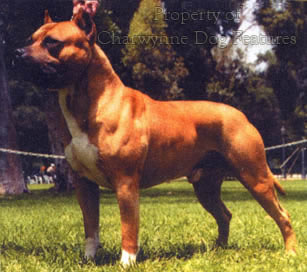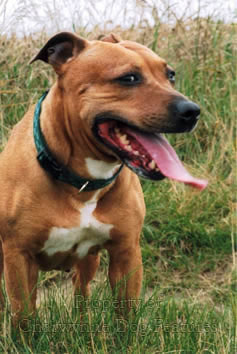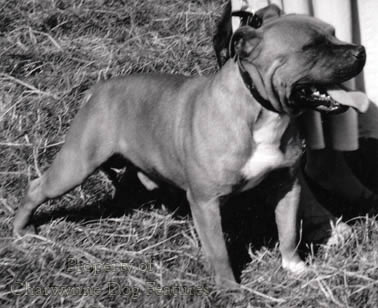682 SAVOURING THE STAFFORD
SAVOURING THE STAFFORD
by David Hancock
 The Staffordshire Bull Terrier is a very special breed, yet one still being punished by ill-informed legislators due to its fighting dog origins. Its famed courage, tenacity and stoicism, once prized in the fight-rings and specifically bred for, now counts against it. The breed is a victim of its own fanciers, with even a show breeder being convicted of dog-fighting offences. Those who misuse them seem to hide behind the good qualities in the breed, perhaps envying their dogs their courage and perseverance in adversity, whilst encouraging combativeness and savageness, often to exhibit their own desire for manliness. It is shameful to pose as being heavily masculine, willing to fight any taker and able to sustain pain unflinchingly, but only through your dog. The current craze for ‘status dogs’, in which young thugs parade their muscular dogs as trophies, at the same time, very transparently exhibiting their own insecurity, lack of self-belief and inability to fend for themselves, is now receiving a police response. But the canine victims, the dogs themselves, will often lose their lives; little lasting harm will come to their exploiters. Dog abuse can take so many forms but few breeds have suffered as much from their own owners as the Bull Terrier from Staffordshire.
The Staffordshire Bull Terrier is a very special breed, yet one still being punished by ill-informed legislators due to its fighting dog origins. Its famed courage, tenacity and stoicism, once prized in the fight-rings and specifically bred for, now counts against it. The breed is a victim of its own fanciers, with even a show breeder being convicted of dog-fighting offences. Those who misuse them seem to hide behind the good qualities in the breed, perhaps envying their dogs their courage and perseverance in adversity, whilst encouraging combativeness and savageness, often to exhibit their own desire for manliness. It is shameful to pose as being heavily masculine, willing to fight any taker and able to sustain pain unflinchingly, but only through your dog. The current craze for ‘status dogs’, in which young thugs parade their muscular dogs as trophies, at the same time, very transparently exhibiting their own insecurity, lack of self-belief and inability to fend for themselves, is now receiving a police response. But the canine victims, the dogs themselves, will often lose their lives; little lasting harm will come to their exploiters. Dog abuse can take so many forms but few breeds have suffered as much from their own owners as the Bull Terrier from Staffordshire.
A colleague of mine, a great Stafford fan, has convincingly argued that the Stafford is the true bull-baiting dog, rather than the Bulldog, and if you look at depictions of dogs in the bull-baiting contests, they are shown far more Stafford-like than Bulldog-like. Bull baiting was very much a Black Country ‘sport’, as was organized dog-fighting at one time. But, as my colleague also argues, the dogs of the fight-pits were more like today’s English Bull Terrier size than the smaller Stafford, although their weights did vary widely. The American Pit Bull Terrier, so widely misused, has an ancestry in bull terriers from Ireland rather than Staffordshire, if experts like Bob Stevens (Dogs of Velvet and Steel), Armitage (Thirty Years with Fighting Dogs) and Colby (Book of the American Pit Bull Terrier) are correct. Not surprisingly, a very different technique was required by the bull-baiting dogs from that of the fighting dogs used in the pits. One characteristic both however had in common was their reliability with people; they were essentially family dogs, brought up with children.
The ill-founded Dangerous Dogs Act of 1991, a knee-jerk response to dog attacks on humans, has victimized the Stafford, totally without sound reason, and entirely because the Kennel Club advised the Home Office to make the Act breed-specific. Now, a thousand dead dogs later, they have changed their minds, without having the magnanimity to admit their crucial error. For any dog to be condemned to death because of its appearance alone is, shall we say, fatally flawed. Vets, despite not being trained to identify breeds of dog, RSPCA inspectors, despite being appointed to prevent cruelty to animals and policemen with insufficient knowledge of dogs, have all been regarded as ‘expert’ witnesses in courts where blameless Staffords have been ‘identified’ as being ‘of pit bull type’. Such activity has brought shame on our once-respected legal system. As with humans, it is behaviour which poses the threat never appearance; the importance of temperament in the breed of Staffordshire Bull Terrier has never mattered more.
In his The Staffordshire Bull Terrier of 1943 (Blackie and Son), the breed expert HN Beilby BSc, a member of the Kennel Club, wrote in his chapter on character and temperament, of three types of Stafford: the outgoing companionable type, the more introspective but more self-reliant type and the small group ‘which is suspicious and of unreliable temper’. He comments that ‘Foolish and cruel treatment of a young dog can have the effect of turning an otherwise normal individual into a member of this group, and there is little doubt that in past days many Staffordshires were so treated in a misguided effort to develop their fighting ability. I say “misguided” because a vicious dog is not necessarily a good fighting dog.’ It is never likely either to make an acceptable pet, especially in a family. I believe that in the 1970s the RAF canine training school did a trial on the breed as attack dogs, perhaps because of their strong ‘bite and grip’ capability, but concluded that even training would not induce a Stafford to bite a human being.
Physical type has long varied in the breed. In his foreword to the book on the breed which he edited, Major Count VC Hollender was writing (in 1952): ‘There were so many dogs sold as Staffords in a boom after the 14-18 war, where Whippets, mongrels, and any small, smooth-coated dogs were used as sires. The modern-coloured Bull Terrier was revived in the same way, and one of the best breeders who ever lived (I refer to Harry Monk, of the Bloomsbury prefix) informed me that Greyhounds, Whippets, etc., were introduced in the modern product. Hence the light, leggy specimens that were first produced.’ Is it at all surprising therefore that light leggy specimens still turn up today, to be dubbed ‘Irish Staffies’ by their fanciers but worryingly attracting the attention of our leading animal charity as ‘being of pit bull type’! If the men of Staffordshire can create their own type of bull terrier from existing stock then I can’t see why other fanciers shouldn’t be free to favour theirs. The size of the breed has long drawn debate.
Writing in that admirable publication Celebrating Staffordshire Bu ll Terriers by Steve Stone, with Vic Pounds, (Pynot Publishing, 2007), veteran breeder Jo Hemstock provides the view that ‘There is no real controversy over size. The Staffordshire Bull Terrier is a medium sized dog that measures between 14-16 inches and weighs 28-38 pounds. Most of today’s winners, and virtually all winning bitches, appear to comply closely with the limits set by the Standard.’ Her daughter Sara, now an experienced judge herself, on an earlier page wrote: ‘I would also say that the dogs of our preferred type have remained fairly consistent down through the decades and have survived both ‘bully’ and ‘leggy’ fads.’ A judge at a championship show of 2008 did however state in the show critique ‘I would like to see more dogs closer to the 38lb mark as required in the Standard.’ It is not always easy to find admiration from judges over the state of movement in the breed, a far more disturbing sign.
ll Terriers by Steve Stone, with Vic Pounds, (Pynot Publishing, 2007), veteran breeder Jo Hemstock provides the view that ‘There is no real controversy over size. The Staffordshire Bull Terrier is a medium sized dog that measures between 14-16 inches and weighs 28-38 pounds. Most of today’s winners, and virtually all winning bitches, appear to comply closely with the limits set by the Standard.’ Her daughter Sara, now an experienced judge herself, on an earlier page wrote: ‘I would also say that the dogs of our preferred type have remained fairly consistent down through the decades and have survived both ‘bully’ and ‘leggy’ fads.’ A judge at a championship show of 2008 did however state in the show critique ‘I would like to see more dogs closer to the 38lb mark as required in the Standard.’ It is not always easy to find admiration from judges over the state of movement in the breed, a far more disturbing sign.
One chapter in the book Celebrating Staffordshire Bull Terriers begins with: “Among purebreds, the Staffordshire Bull Terrier stands out as being an athletic Breed, a fact all too few Staffords fanciers fully appreciate and those owning most other breeds seldom realise. The Stafford’s athletic abilities remain a key factor in its continuing to be a foremost all-purpose dog and so bred-in-the-bone that not even many generations of being bred primarily for show has exerted much detrimental effect.” But if you study the critiques from recent championship dog shows, where it is claimed that only the best appear, you see a different picture. Here are some of the judges comments: “many exhibits carry far too much weight…many exhibits displayed a distinct lack of rib and forechest”; “narrow fronts and bodies also upright pasterns”; “shoulders and fronts have deteriorated alarmingly”; “poor rear movement with many lacking drive”; “I do feel that we need to work our way back to a correct blend of bull and terrier not one or the other”; “rear movement was poor” and “I was quite alarmed by the number displaying features which depart so much from the Standard that there is a real possibility of breed identity being lost if we continue down this path.”
Whilst it is good to see the honesty in such remarks, it is worrying to read such consistent criticism of some features over several years. I see Staffords in the show ring with very poor feet, feet more suitable for a Whippet, and they win! I see many without muscular development and in this breed that never looks impressive. An unfit waddling Stafford looks dreadful and insults the heritage of the breed. A poorly constructed Stafford will never move well. Writing in the first issue of the magazine The Stafford in 1948, the respected breeder Jimmie Russ stated that: “The foundation of the dog is the skeletal structure…Too heavy bone is usually coarse, and being heavy is slower in movement. Light bone on the other hand is fast but lacks strength. Aim for good, clean, straight bone, with neither frailty nor coarseness. Aim for quality, which is neither coarseness nor lightness. Your Stafford will lack the speed of a Whippet, but he will be surprisingly fast in the manner of a first-class welter-weight boxer.” That last phrase sums up this breed for me; the Stafford should be the welter-weight of the dog breeds, fit, muscular, fast on its feet, alert and full of vigour. This is a very special breed, whose blood is rightly prized in a number of other breeds or types. Staffordshire has given us a quite admirable breed of dog and one which needs our support more now than ever before.